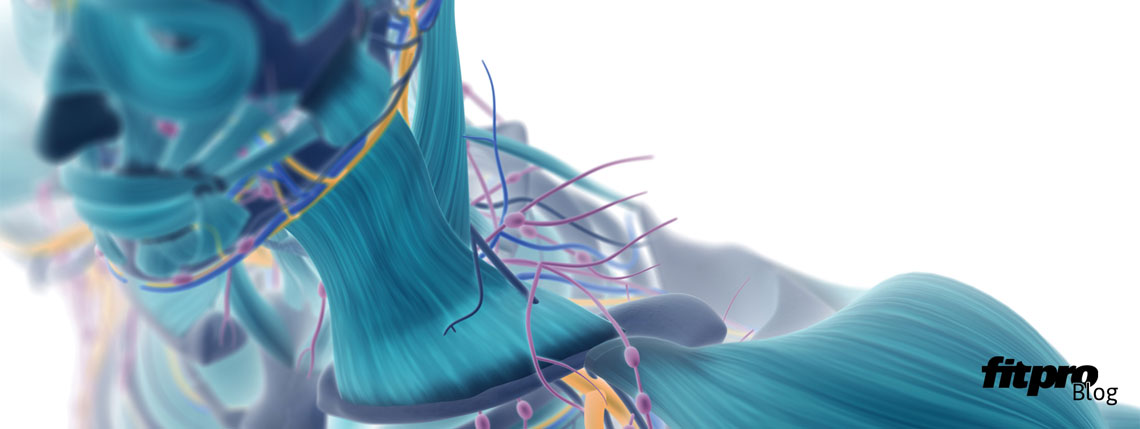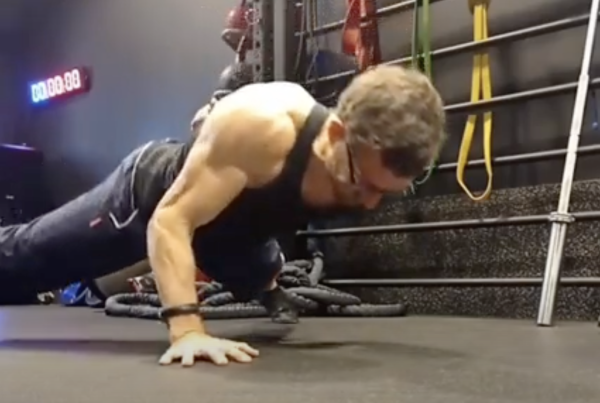Certain exercises and stretches can aggravate clients’ nerves, but some postural adjustments can be all it takes to reduce the risk of neural tension and discomfort says physiotherapist, exercise scientist, health educator and clinical Pilates instructor Merrin Martin.
Back in the 80s when I first started out in the fitness industry, I remember wearing my leg warmers (now there’s a vision!) and completing my Australian Physical Education course and learning about how to stretch a muscle. One of the favourites to include in fitness classes was a hamstring stretch. During my classes I would do a straight leg hamstring stretch and tell the participants to flex the foot or pull their toes towards them to increase the stretch. I thought I was challenging my class to increase their range of motion, giving them a better class as a result.
Little did I know that while doing this stretch I was increasing the neural tension in the leg. I never considered whether a class participant could have had a past hamstring tear with neural adhesions, or whether they could be an office worker with a history of low back pain and weak pelvic stability causing piriformis to spasm. I never asked anyone about their history of lumbar spine disc injuries causing an increase in neural tension… so much to learn! When I think back to the stretches I was instructing, I could have made a lot of my clients feel worse, as opposed to challenging them to increase a stretch. Participants would routinely comment at the end of class that they felt a sharp pull in their calf muscles or behind the knee and did not achieve a stretch in the hamstring muscles. Have you ever heard this from clients or participants? If so, read on.
You’ve got a nerve
Let’s recap some anatomy of the nervous system. There are two main components to the nervous system: firstly, the Central Nervous System (CNS), comprising mainly the brain, brainstem and spinal cord; and secondly, the Peripheral Nervous System (PNS), which connects the spinal cord with our limbs and organs. When we stretch the arms and legs within an exercise session, we are mainly putting tension on the PNS. However, we must remember the CNS and PNS cannot be separated and are one continuous structure within our bodies. Anything we do with our arms and legs can also be felt elsewhere in the body. Nerves are not elastic and therefore do not respond well to static stretching. Nerves are more like a tight piece of thick string that, if stretched under static load, will become irritated. Do not push through the hamstring stretch if you feel a pull in the calf muscle. In addition, nerves do not respond well to compression. So if you think that using a foam roller to apply super hard pressure to your sciatic nerve will help to ease the pain, think again! Rather than being put under prolonged stretch tension or directly compressed, nerves need a pathway free of pressure to travel through the body and ensure we are pain-free and functioning optimally.
Getting on clients’ nerves
Clients with irritated nerves may vocalise a feeling of having ants crawling up their skin, water moving on their skin, or an increased awareness of a particular part of the body. They may report tingling or pins and needles in a particular area, or a localised numb feeling or loss of sensation. As symptoms worsen, they may report a shooting pain, hot pain, or a stabbing pain that is very sharp in quality. A physiotherapist can do a specific neural assessment that may also reveal additional nerve symptoms, such as loss of reflexes or overactive reflexes, or reduced strength and control within a certain group of muscles that correlate to a particular level of neural compromise. If your client has these severe symptoms, they must be referred on to a health professional for further diagnosis of the origin of their pain before continuing with their exercise programme.
Optimal nerve function: top tips for PTs
- The first thing to remember when you instruct a client to stretch is that you are increasing the tension, pull or static stretch on every structure that limits movement at a particular joint in a particular direction (i.e., hip joint flexion). The structures responsible for increasing tension and reducing range of motion within a stretch could be muscle, nerves, veins, arteries, fascia and connective tissues, joint capsules, ligaments and so on. Be aware that you are not only stretching one muscle when you give a stretch.
- Secondly, all of us are made differently, with unique tissue extensibilities and genetic makeup, and therefore we will all feel a stretch differently. There is no advantage in doing a hamstring stretch when the problem limiting an increase in range of motion is pins and needles in the foot and no stretch in the hamstring. Always ask your client where they are feeling a stretch and what the stretch feels like. This may shed some light on whether they are feeling the muscle stretch correctly.
- Thirdly, bear in mind that the nervous system is a continuous system throughout the body, therefore your body posture, head position, foot position or hand position can actually make your nerves become more irritable within a given stretch. It is important to take note of the posture of your client when they feel any nerve symptoms and to make sure you avoid this body posture within a given exercise session. For example, a client may say they get tingling in their hands when they do a pec stretch at 90 degrees of abduction, but it may be the fact that their head is turned away or laterally flexed from the shoulder they are stretching, which increases neural tension in the median nerve in the upper body, resulting in the tingling sensation in the hand. Returning the head to a more neutral position and making sure there is a slight bend in the elbows may be enough to decrease the pull on the nerves. Be aware of the whole body posture when performing stretches.
10 common mistakes that may increase neural tension
The following behaviours during a workout may increase neural tension, so familiarise yourself with the solutions and educate your clients about how a simple change in posture can help reduce this risk.
- Cervical flexion, i.e., looking at the floor when performing exercises (cervical plexus tension)
Solution: Keep neck in a neutral, forward-looking position
- Pulling the scapula/shoulder girdle down and back excessively when doing upper-body exercises (cervical plexus tension)
Solution: Perform correct backward tilting of the scapula without excessive depression of the scapula during upper-body exercises
- Sitting on a hand to perform a neck stretch and/or pulling the neck with the other hand (cervical plexus tension)
Solution: Very gentle movements of the cervical spine; don’t hold a stretch longer than five seconds for the cervical spine and never sit on the hand to pull down the shoulder or pull the head in the opposite direction
- Tilting the head away from an arm when you are stretching (cervical plexus tension)
Solution: Keep the head looking forward or towards the hand/arm you are stretching to reduce neural tension, and relax the opposite arm by your side
- Straight leg hamstring stretches (sciatic nerve tension)
Solution: Perform bent knee hamstring stretches with a relaxed ankle – bring the knee in towards the chest as far as possible before attempting to straighten the knee (this way the proximal or upper hamstring will have more of a stretch sensation and the neural tension behind the knee will reduce significantly)
- Excessive wrist flexion with upper-body weights (median nerve tension)
Solution: Keep wrists neutral and not flexed when performing rowing or lat pulldowns to reduce the tension on the forearm or wrist flexors, thereby helping to offload the median nerve in the carpal tunnel
- Bilateral (both arms) pec stretch position (brachial plexus tension)
Solution: Perform upper-body stretches one arm at a time with neck and head in a neutral position and relaxed shoulder position
- Sitting in a ‘C’ curve or rounded spinal position (slumped rounded kyphotic posture) to do weights, i.e., seated leg press (spinal cord tension)
Solution: Ensure your client is not doing leg weights in a seated position, rather do standing or upright functional leg strengthening exercises, and make sure their posture is in a more neutral spine position and not a rounded sitting posture
- Rounded lumbar spine in deadlift posture (sciatic and spinal cord tension)
Solution: Make sure knees are slightly bent to reduce tension, and keep lumbar spine in neutral position with slightly lordotic posture
- Don’t tuck chin in to chest, rather keep a slight gap between chin and chest; sit and reach test position – worst combination of bilateral straight leg stretch with rounded posture and cervical flexion! (spinal cord flexion)
Solution: If you are sitting in a long sitting position, sit on a block to reduce slump of the lumbar spine, bend your knees slightly or place a towel under your knees and keep your spine and head as upright as possible, this will reduce pull and tension on your nerves
When I reminisce about my aerobic days in the 80s, I wish I had more awareness of what structures I was affecting with my stretches and exercises. It is important to remember that you are not only working muscles, but all the other structures that work in unison with the muscles, including the nervous system.
Of course, if there are neural symptoms that worsen during a session, you must always stop the exercise and refer the client to a health professional for diagnosis. Never push through the neural symptoms – respect the nerves!
For references, read this article at fitnessnetwork.com.au/resource-library
Merrin Martin, BAppSc (Physio), BSpSc (Ex.Sc) is the founder of Active Anatomy Physiotherapy & Health Professional Workshops in Sydney. An experienced physiotherapist, exercise scientist, health educator and clinical Pilates instructor, Merrin is a highly respected expert in exercise rehabilitation. activeanatomy.com
Where next? Meet LJ Flanders who while in prison created a bodyweight training book to help other inmates. Read ‘The Cell Workout’ here







